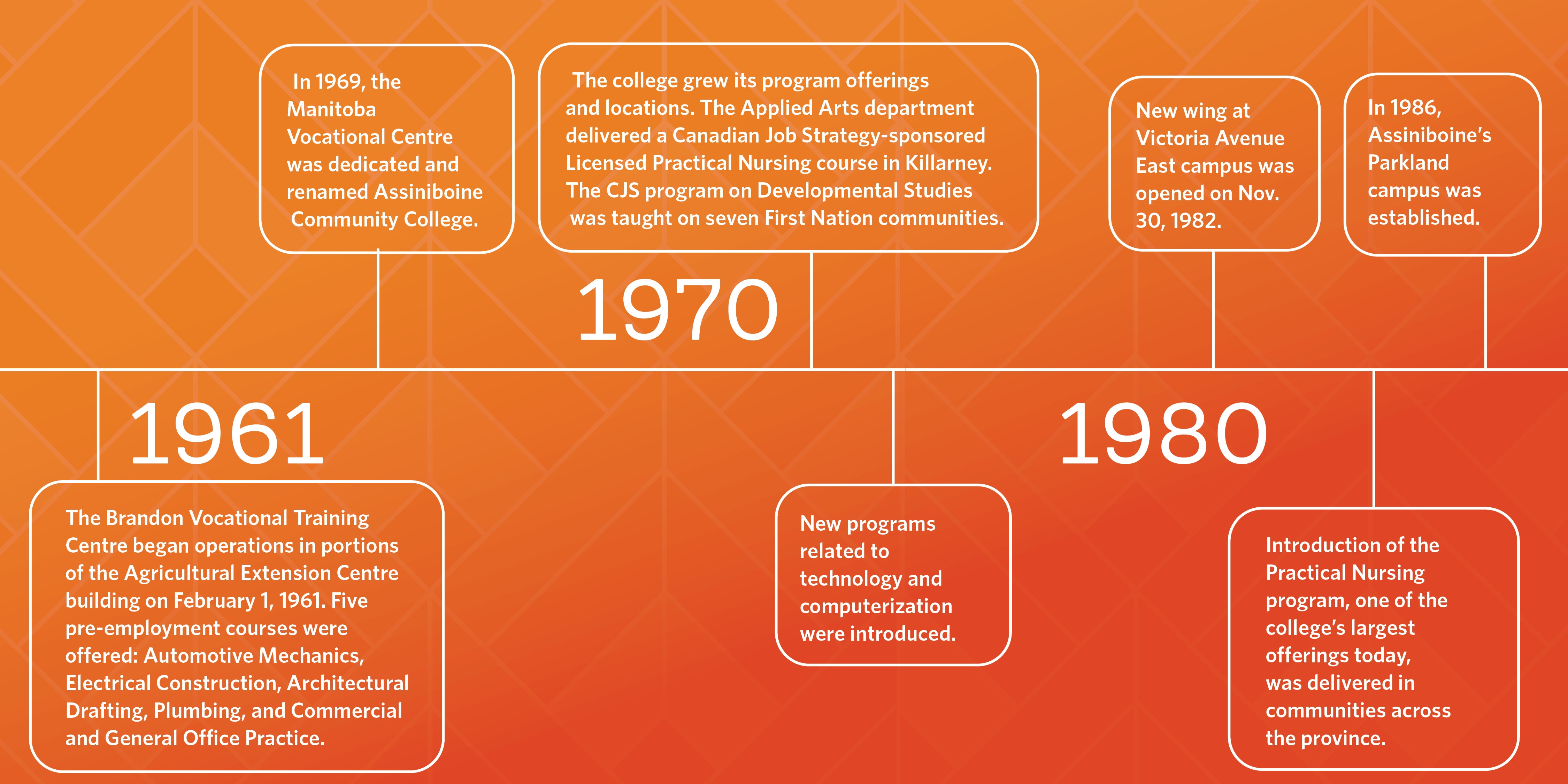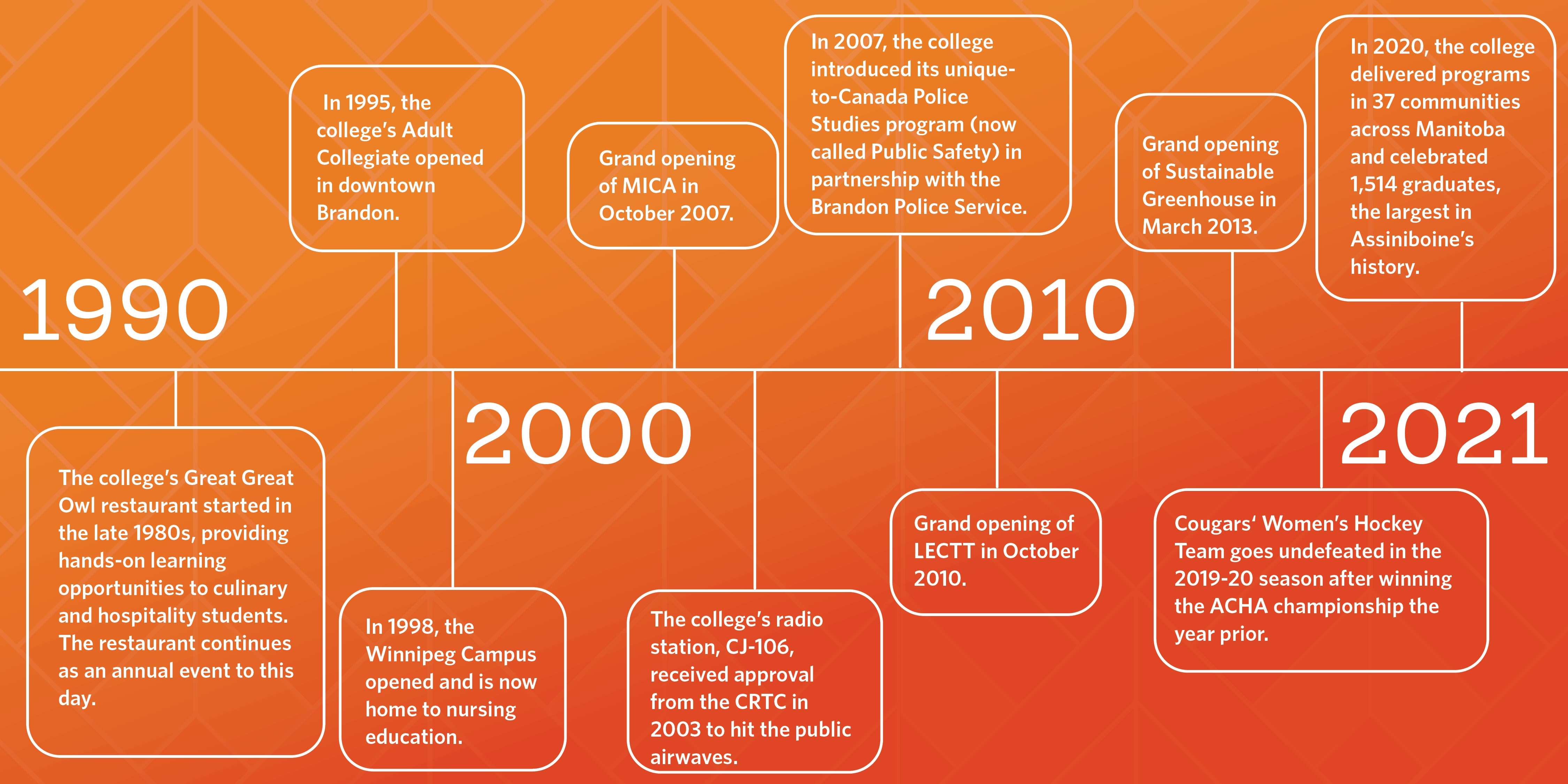Assiniboine Turns 60
March 2, 2021
2021 marks two large milestones for Assiniboine, 60 years offering post secondary education as a leading educational institution and 35 years of the Parkland campus.
This history passage was written by Diane Nelson as part of a special 60th anniversary history book currently in progress.
Throughout the decades this not-so-small college on the Prairies has gone through many transformations to become what it is today, a cutting-edge post-secondary educational facility. From its humble beginnings as The Brandon Vocational Training Centre, the college has always been hailed as being not only on top of things, but also remaining ahead of the curve.
The College’s dedication to providing something more, something extra, something special—evidenced by its pledge to deliver “exceptional learning experiences”—was as true in yesteryear as it is today.

It’s said the more things change, the more they remain the same. And that’s certainly been the case with Assiniboine Community College. In 1961, a shortage of people with training in the skilled trades motivated the creation of the entity that became ACC.
The Brandon Vocational Training Centre began operations in portions of the Agricultural Extension Centre building on February 1, 1961. Five pre-employment courses were offered: Automotive Mechanics, Electrical Construction, Architectural Drafting, Plumbing, and Commercial and General Office Practice, by the end of March, a total of 84 students were enrolled.
Enrolment kept increasing, and more instructors were hired to cater to a local population obviously hungry for education and training. By the beginning of the 1963 academic year, the number of students in Automotive Mechanics had doubled from the preceding year, so a second class was offered. The Commercial and General Office course was divided into a Stenographic course and a Clerical and Machines course, offering the potential for up to 50 students in the business area. College staff increased to 12 people during the peak enrolment periods, and almost 400 students attended the college over that year.
In 1964, the college’s name was changed to The Manitoba Vocational Centre. And in January of that same year, the first formal graduation was held. Seventy-seven students received Certificates of Attainment, and 28 received Certificates of Qualification. Before the academic year was out, the staff complement reached 17. Four social events were conducted over the year by the student council, and a curling league was formed which ran through the winter. Enrolment reached a peak of 239, up from 162 in the 62-63 season.
On October 27, 1966 the first students moved from their temporary quarters to the almost-completed 22-acre site on Victoria Avenue East. The building incorporated some 120,000 square feet (approximately one hectare) and was home to 23 training courses. In addition, the building soon became host to an ever-increasing range of evening programs designed to provide the citizens of Brandon and the surrounding area with every opportunity to further their knowledge in a variety of fields or embark on self-improvement.
On December 15, 1969, the Manitoba Vocational Centre was dedicated and renamed Assiniboine Community College.
In the ‘70s, the college was expanding well beyond its physical walls. The college provided curriculum and support materials to Hamiota Collegiate in the delivery of Small Motor Mechanics program. The Agriculture department registered more than 1,600 individuals for the many programs and courses offered in more than 73 communities. A new Entrepreneurship in Agriculture program was delivered in three locations. In addition, several agricultural programs were offered via distance education. More than a thousand individuals took advantage of the programs offered by the Business, Industrial and Continuing Education department. Gross revenue for the year was $1.3 million. Distance education enrolment increased by 20 per cent over the previous years.
In the ‘80s Assiniboine continued it’s growth, in both students, program offerings and physical space with a new wing opened on Nov. 30, 1982. The addition was 93,000 square feet—a 50 per cent increase in space at the Victoria Ave East campus. The interest in, and focus on, technology and computerization that had begun in the ’70s really came to the fore during the 1980s. In 1986, Assiniboine added what was hailed as an educational revolution in Manitoba: video conferencing. Commonplace nowadays, the college was praised, as it so frequently was, in local and provincial media for introducing such an advanced technological option to its bounty of offerings. Assiniboine was blazing trails at every opportunity, and the public and the powers-that-be were taking notice.

The Great Grey Owl Restaurant, named after Manitoba’s provincial bird, was established in the late 1980s.The first incarnation was staged in a separated section of the cafeteria and was decorated with lights and candles and, of course, elegant table settings. The excellence of the food and the then-reasonable prices were a huge hit with the local community; and a meal at Great Grey Owl has been the hottest ticket in town for the past 30 years. But further advancements in the program were forthcoming, and they all took place in the next two decades.
Moving into the ‘90s Assiniboine and the Chefs Association partnered to create a program for cooks who had been in the food industry for five years to allow them to write the exams for their Red Seal, a governmental designation of a high level of competency in one’s field. Assiniboine’s programming in agricultural education was also hailed as an asset to the area in the 1990s, and among other things, the college offered a high-tech pilot project aimed at rural women. As well, a Licensed Practical Nursing (LPN) business course was developed that was also specifically directed at farm families. Assiniboine’s early foray into online learning continued to bear fruit. During the next three years, Assiniboine was the only community college in Canada to offer a complete two-year Business Administration diploma through distance education.
As time passed, Assiniboine welcomed in the 2000s, bringing with it further unprecedented growth within the Westman region.
2000 began in January with what for many years was the annual Hot-Tub-A-Thon, a fundraiser in which the Ag and Environment students took turns in a hot tub in freezing cold January weather to raise money for diabetes research and support. In 2002, Assiniboine was the first organization in the province to install a new telephone system called an Internet Protocol Telephony Network. As the decade progressed, the college made application for its 24-hour campus-community radio station license, CJJJ. Better known as CJ-106, the station finally got the formal nod from the CRTC in 2003, and media students who previously had just been broadcasting in-house at the college were now legitimately on the airwaves, with their efforts accessible to all within a 20-mile radius of Brandon.
Closed in 1993, the buildings of former Brandon Mental Health Centre had sat empty for a long period of time. It was proposed that the architecturally significant buildings and gorgeous grounds would make a natural campus, that the area should be repurposed as a hub for education. Campaign Assiniboine, which was to raise funds to assist in the realization of this vision, was launched in January of 2007, and plans for the extensive North Hill campus were publicly unveiled in November, with projected completion slated for 2011. The launch of the Manitoba Institute of Culinary Arts (MICA) took place on December 6th, 2006, MICA was officially opened with much fanfare on October 5th of 2007. The next major happening of the decade occurred in June of 2008, when it was confirmed that funding had been approved for the building of the Len Evans Centre for Trades and Technology on the North Hill Campus. Construction commenced soon afterward, and the college looked forward to welcoming the new decade with another freshly minted facility.
As the College welcomed in the 2010’s the number of programs available would surplus 50 and the college would see record number of international students consistently enrol at Assiniboine. With more than 4,000 students, and campuses in Brandon, Dauphin and Winnipeg, the college provides comprehensive educational opportunities throughout Manitoba. The college also continued to partner with many communities and organizations across the province to deliver customized education and training. By the end of 2019 Assiniboine’s annual provincial economic impact
was $613 million.



